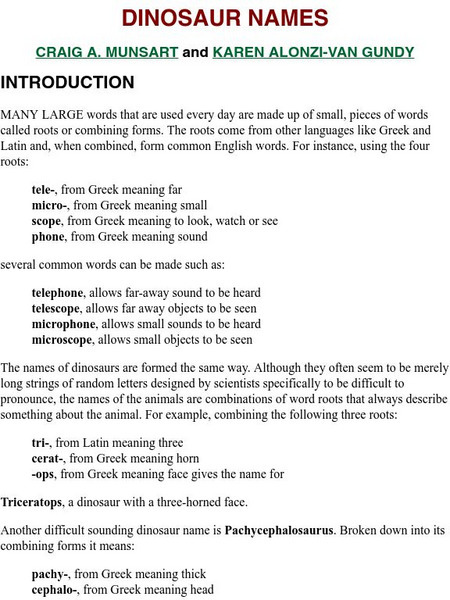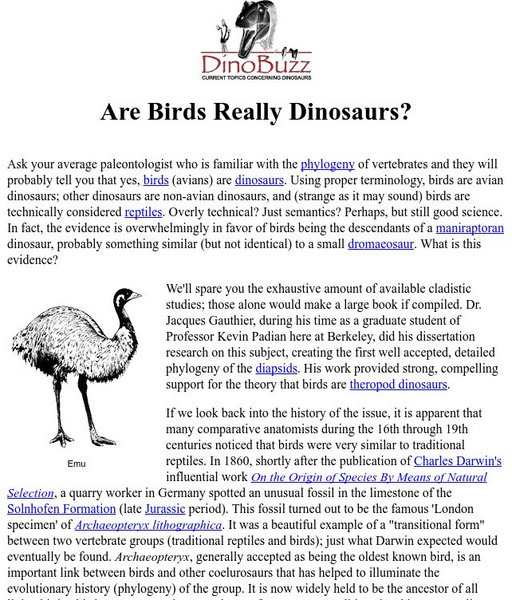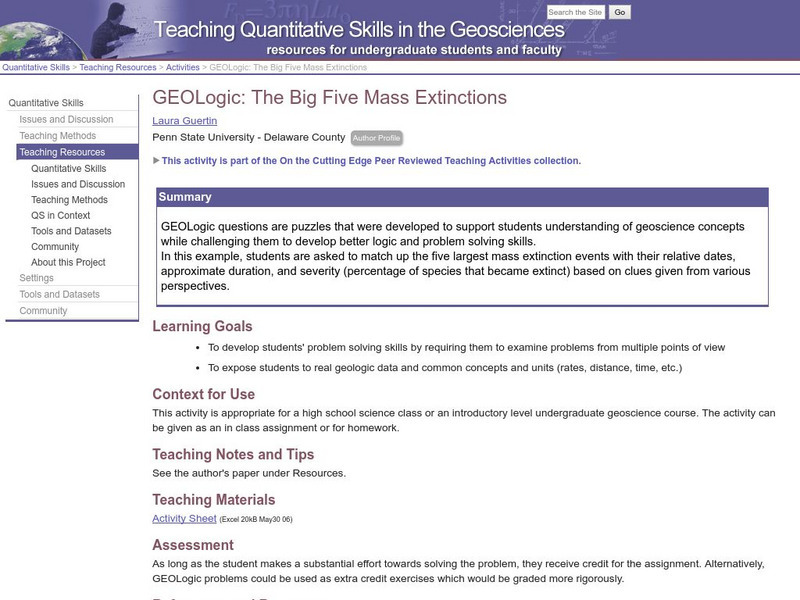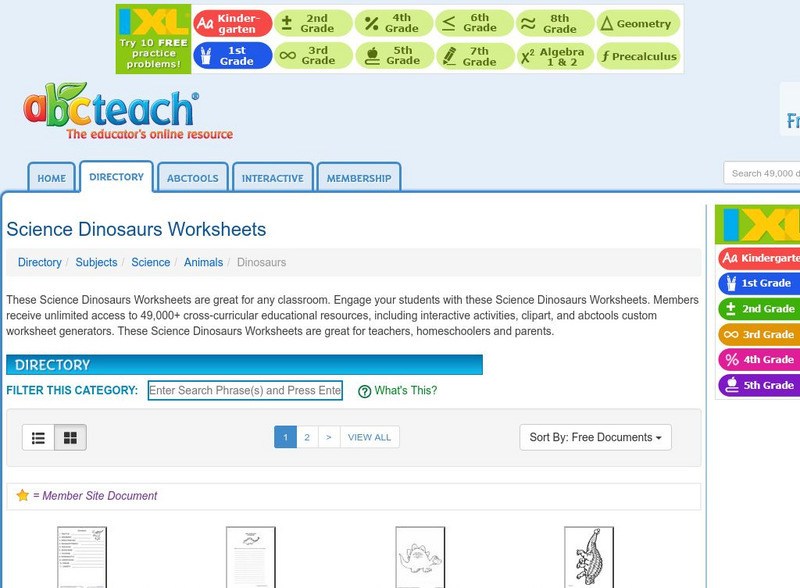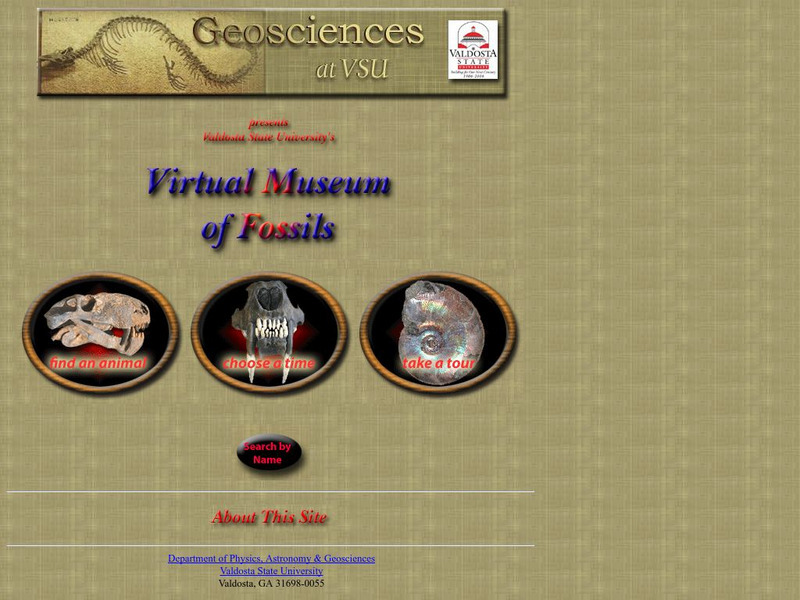PBS
Pbs Kids: Dinosaur Train: Field Guide
The dinosaur train field guide is an A-Z glossary of dinosaurs for younger children. Each dinosaur has a colorful picture, and tabs showing an x-ray, a size comparison, the food it eats and some facts about it. The text is accompanied by...
Other
New Mexico Museum of Natural History and Science: Coelophysis
The Coelophysis is New Mexico's official state fossil. It lived in the late Triassic Period and has only been found in New Mexico. Popular questions about this dinosaur are answered here. In addition, there are numerous documents about...
American Museum of Natural History
American Museum of Natural History: Dinosaurs: Bambiraptor and Birds
A 14-year-old boy found the fossils of a brand new species of dinosaur--the Bambiraptor. Find out the fun facts about what scientists have discovered about the Bambiraptor and how closely it was related to birds with this resource.
University of California
University of California Museum of Paleontology: Understanding Evolution
This resource presents extensive information for learning about and teaching evolution including an in depth course "Evolution 101", teaching materials, and a resource library.
Michigan State University
Michigan State University: Lets Net: Dinosaurs and Us Unit
The focus of this lesson unit is on adaptation - how dinosaurs adapted to their habitat in order to survive. Students will explore online dinosaur exhibits and record information they find. This leads to a discussion of adaptation and...
Lawrence Berkeley National Laboratory
Berkeley Lab: The Fruitful & Inventive Mind of Scientist Luis Alvarez
This article, reprinted from the fall 1979 LBL News Magazine, was written about Dr. Luis Alvarez and his part in the study of geological sediments and the great extinctions.
Scholastic
Scholastic: Dinosaurs: Dino Don's Dinosaur Quiz
Test how 'dinosaur smart' you are by taking this dinosaur quiz by Scholastic. Learn interesting facts about dinosaurs while you take this quiz.
University of California
Ucmp: Name a Dinosaur Activity
This article shows how scientists put together the scientific names of dinosaurs using Greek and Latin roots.
American Museum of Natural History
American Museum of Natural History: O Logy: Beyond T. Rex
Launch this OLogy link to find a dinosaur cladogram, an illustration that organizes dinosaurs into groups based on the unique characteristics they share, like a three-toed foot.
University of California
Ucmp: Are Birds Really Dinosaurs?
A great essay that illustrates how science is done as well as the relationship between dinosaurs and modern birds. Includes a picture to illustrate this concept, and contains many links to related sites.
University of California
Ucmp: The Tyrant Lizards: The Tyrannosauridae
This site from the University of California provides basic information on T. rex with links to related material great for a quick introduction.
University of California
Ucmp: Inferring the Possible Speed of Dinosaurs
An essay detailing the evidence used to determine how quickly dinosaurs moved. Includes pictures of fossilized dinosaur tracks.
University of California
Ucmp: Dinosaurs, Movies, & Reality
A very good review of how "movie science" can present an inaccurate or incomplete picture of actual scientific knowledge and methods.
Tramline
Tramline: Dinosaurs: A Prehistoric Adventure for Grades 2 5
Click "Start Fieldtrip," for a wonderful look at a subject that has been a constant amazement to children of all ages. This dinosaur learning module for grades 1-3 is a "Prehistoric adventure," discussing dinosaur fossils, the size of...
New York Times
New York Times: Dinosaurs
[Free Registration/Login Required] Many, many articles about dinosaur discoveries have been published in the New York Times over the years. This collection goes back to 1983 and presents a rich source of material for student research.
Science Education Resource Center at Carleton College
Serc: Geo Logic: The Big Five Mass Extinctions
Using GEOLogic puzzles, learners are asked to match the five largest mass extinction events with their relative dates, approximate duration, and severity based on clues given from various perspectives.
University of Wisconsin
The Why Files: Fecund Feces
For those with strong stomachs, this article introduces the scientific study of dinosaur feces, giving an idea of the vast amount of information that can be dertermined about dinosaurs from a large pile of dung.
abcteach
Abcteach: Dinosaurs
[Free Registration/Login Required] This resource features a variety of activities related to dinosaurs. There are interdisciplinary tasks that include writing exercises such as creative writing and story planner formats. Lessons for...
Chase Young, PhD
Dr. Chase Young, Ph D: Reader's Theater Script: Dinosaur Land [Pdf]
A reader's theater script for Dinosaur Land is provided on these pages. Two character roles are needed in this play that reinforces the difference between dinosaurs that are omnivores and carnivores.
TED Talks
Ted: Ted Ed: When Will the Next Mass Extinction Occur?
Borths, D'Emic, and Pritchard give a quick history of mass extinctions. [5:01]
SEDL
Sedl: Extinction
This second lesson in a course on dinosaurs is devoted to extinction. There are group activities, discussion of the idea, and a way to assess what the students have learned.
American Museum of Natural History
American Museum of Natural History: O Logy: What's the Big Idea? Paleontology
Snapshot reference on paleontology explains how the fossil record drives this area of science.
SEDL
Sedl: Dinosaurs
This site provides wonderful lesson plans about dinosaurs. Seven sequenced units cover the following topics: extinction, fossils, types of dinosaurs, and the dinosaur life cycle. The site provides basic lesson and background information...
Other
Valdosta State University: Virtual Museum of Fossils
This resource provides an interactive introduction to paleontology. Take a tour, search by animal or time period, and peruse for hot links throughout the museum.









